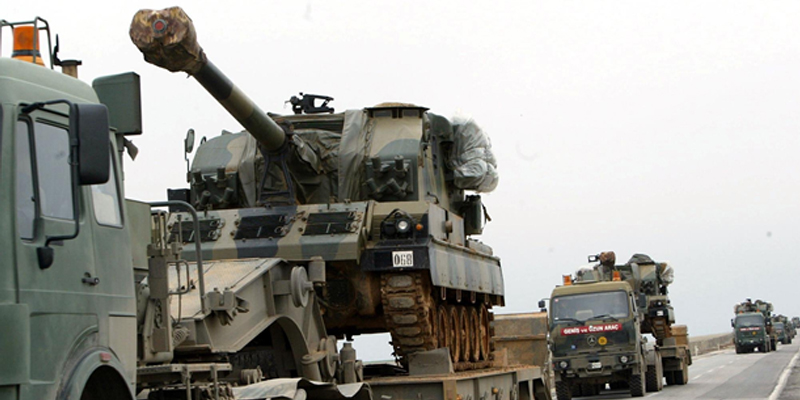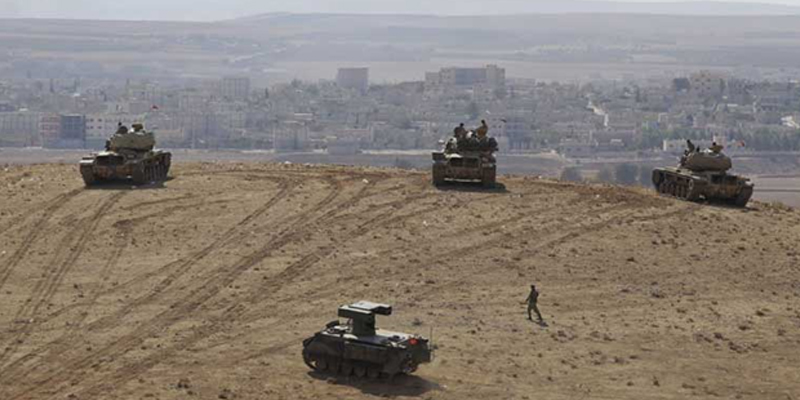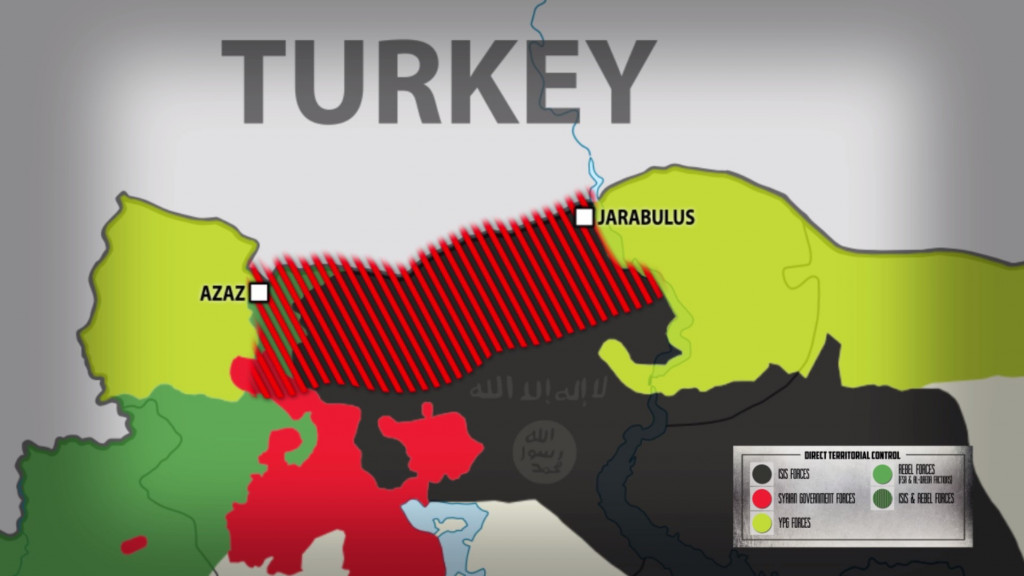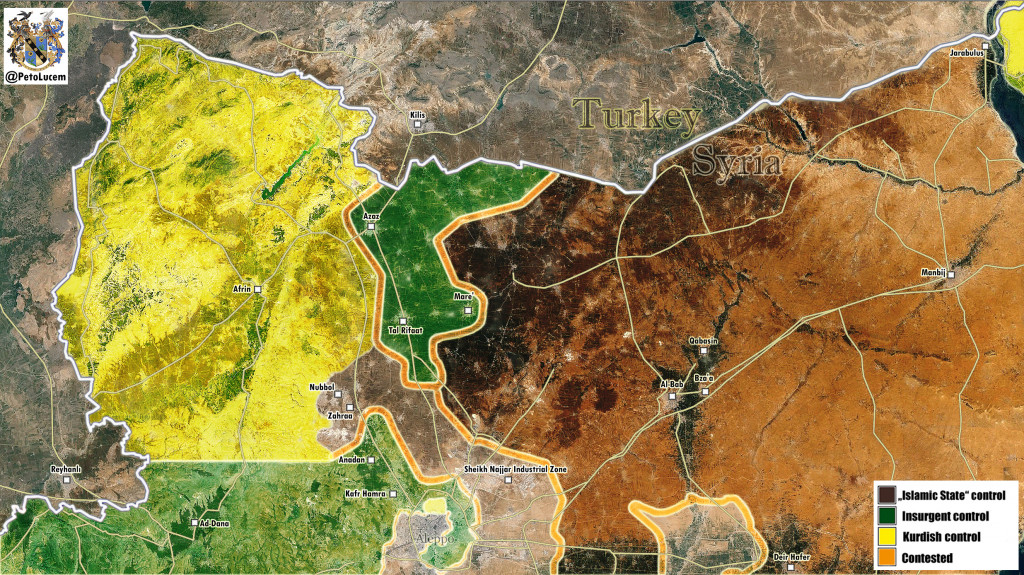Today, Turkey has invaded Syria near the border town of Jarablus. The text below analyses Turkish forces that can be involved into the operation. It was originally appeared at SouthFront on February 12, 2016.

Written by Brian Kalman exclusively for SouthFront: Analysis & Intelligence. Brian Kalman is a management professional in the marine transportation industry. He was an officer in the US Navy for eleven years. He currently resides and works in the Caribbean.

Recent public comments by the Turkish government have hinted at a possible invasion into Syrian territory to “stabilize” the situation and secure Turkey’s national security. Significant clashes between Turkish army and security forces with elements of the YPG and PKK, which have exacted a costly toll on the Kurdish civilian population have been raging in southern Turkey and northern Syria in recent months. Russian satellite surveillance and human intelligence employed by both Russian and Syria in the region have confirmed the build-up of troops and material on the border.
It is reasonable to believe that Turkey is preparing to salvage its failed policy of supporting Islamic fundamentalist mercenaries and terrorist groups in Syria by invading and establishing a safe area for these groups along its southern border with Syria, while at the same time dealing a crushing blow to the Kurdish forces that have been successful in fighting them. Turkey is not only trying to topple the Assad government in Syrian, but is also trying to liquidate the Kurdish threat both in Iraq and Syria, as well as within its own borders.
Turkey’s membership in NATO complicates its plans of invasion. Unless Turkey is itself attacked, the NATO alliance is not obligated to defend the nation. Turkey will have to engineer a provocation that frames it as the target of an aggression either by Kurdish forces from beyond its borders or by Syrian or Russian forces combating its terrorist allies in Syria. Such a false flag provocation in not outside of the realm of possibility. When a Turkish F-16 shot down a Russian Su-24, claims that the bomber had strayed into Turkish airspace for a number of minutes and ignored radio warnings from the Turkish aircraft were proven to be patently false. A year earlier in 2014, an audio recording of Turkish officials, including the head of the Security Service (MIT), Deputy Chief of the General Staff, Foreign Minister and the Undersecretary to the Foreign Minister discussing staging an attack on the Tomb of Suleiman Shah (a sovereign piece of Turkish territory) in Syria and using it as a pretext to intervene in Syria were leaked anonymously on YouTube. The Turkish Prime Minister Recep Erdogan responded by banning YouTube in Turkey, in affect giving support to the recordings authenticity. Now that the Syrian government has the upper hand militarily, gaining back territory and destroying, surrounding or pushing back various Turkish-backed terrorist forces, Turkey may be ready to engineer a new excuse to invade.

It is most likely that elements of the Turkish Second Army are positioned along the southern border with Syria, and will form the nucleus of any invasion force. The 2nd Army is responsible for defending Southwestern Turkey. Its headquarters is based in Malatya, with approximately 100,000 troops under its command. The army is comprised of three corps, the 4th, 6th and 7th which are composed of the following units:
- 3rd Tactical Infantry Division
- 28th Mechanized Infantry Brigade
- 58th Artillery Brigade
- 1st Commando Brigade
- 2nd Commando Brigade
- 5th Armored Brigade
- 39th Mechanized Infantry Brigade
- 106th Artillery Regiment
- 34th Border Brigade
- 16th Mechanized Brigade (Diyarbakır)
- 20th Armored Brigade
- 70th Mechanized Infantry Brigade
- 172nd Armored Brigade
- 2nd Motorized Infantry Brigade
- 6th Motorized Infantry Brigade
- 3rd Commando Brigade
- 107th Artillery Regiment
It is not known how many elements of the 2nd Army have been committed to the build-up of forces on the border, nor how many elements of other Armies of the Turkish Armed Forces have been temporarily attached to this possible invasion force. Additional commando or mechanized units could be pooled from other military districts and added to the core of mechanized infantry, armor and artillery forces of the 2nd Army. It is surmised that most of the 2nd Army has been committed to a possible invasion or a limited offensive operation against the forces of the YPG all along the border. The map below shows the position of these units:


Photographic evidence shows that the mechanized and armored forces being used in the internal operations against the Kurds within Turkey and Syria and also the incursion into northern Iraq, are composed of relatively modern tanks and infantry fighting vehicles (IFVs). Reports have recently been made public that over 1,000 pieces of military equipment, likely consisting of MBTs, IFVs, self-propelled and towed artillery and their prime movers, as well as trucks and light vehicles have been massing in staging areas just north of the border. Turkish military spokesmen have stressed that they have positioned approximately 30 percent of the Turkish land forces along the border with Syria.
The troops belonging to these units are highly trained and motivated. They have been engaged in fighting in the border regions for many years and know the territory well. They have also been engaged in fighting the irregular forces of the PKK in urban areas for decades. The forces assembled are equipped with modern, effective combat arms and equipment that has been proven in battle.
From video and photographic evidence, Turkey has deployed at least the following types of equipment:
MBTs:
- M-60T (Turkish version of the Israeli Sabra Mk.II).Turkey has 170 M-60-Ts in service. This modernized and up-gunner version of the M-60, is an Israeli design. It boasts better armor protection than the M-60A3, as well as a more powerful 120mm main gun and better fire-control and imaging systems.

A modernized M-60T (Sabra Mk. II) on maneuvers.
- M-60 ATT and A3. Turkey has 762 of these U.S. designed tanks in service. This is a sound tank design, but is not on par with later generation MBTs. Armored units, possibly of the 5th, 20th or 172nd Armored Brigades utilizing large numbers of these tanks have been seen deploying to the southern border in the previous weeks. They were used during incursions into Syria and Iraq in earlier operations to combat Kurdish forces in both nations.

M-60 ATT/A3s deployed in northern Iraq in 2015, most likely of the 172nd Armored Brigade.
- Leopard 2A4. Turkey has 354 of these highly capable German manufactured tanks. It does not appear that these MBTs are in use by any of the armored units currently deployed in operations against the Kurds in the south of the country, nor incursions into Syria or Iraq. It is most likely that these more capable MBTs are with units tasked with guarding Turkey’s border with Russia and the Caucasus, where they would have to fight against a much more capable adversary, utilizing more modern and capable MBTS and Anti-Tank (AT) weapons.
IFVs:
- FNSS ACV-15. Based on the Turkish Army’s experience with the U.S. M113, the ACV-15 is an indigenous design that has many variants including APCs, Mortar Carriers, Ambulances, and ARVs. The IFV is equipped with a 25mm cannon.

A recent photograph of a mechanized unit equipped with ACV-15s assembled in the Turkish town of Suruc, approximately 100 miles north of the Syrian city and stronghold of ISIS, Raqqa.
MRAPs:
- Kirpi (Hedgehog). Turkey acquired MRAPs after the U.S. invasion of Iraq exhibited the weakness of most light vehicles when confronted with IEDs and urban ambush. Turkey has between 200 and 600 MRAPs of this indigenous design.

Turkish Army Kirpi MRAP on duty somewhere in southern Turkey.
- Approximately 1200 of these small MRAPs exist in the Turkish Land Forces inventory. These are small utility vehicles much like the Russian Tiger or U.S. HUMMV; however they have increased survivability against mines and IEDs, as they were purpose built to deal with these threats. They are widely used by all Turkish land forces, including border and internal security forces.

Cobras being utilized by a Turkish Army Border Brigade in southern Turkey.
Self- Propelled Artillery:
- T-155 Firtina self-propelled howitzer. The T-155 was the product of a joint venture with South Korea to develop a more modern self-propelled howitzer. The South Korean variant is known as the K9. The Turkish Firtina makes use of the chassis and 155mm/L52 gun of the South Korean K-9, but uses an indigenous turret design, and navigation, communications and fire-control systems. There are at least 280 units in service with the Turkish Army.

T-155 self-propelled howitzers on the firing line.
- M-52T self-propelled howitzer. A major modernization program was conducted in the 1990s to modernize a weapons system that was developed in the 1950s by the United States. The vehicle was up-gunned from a 105mm howitzer to a German produced 155mm L39 gun. Turret design was modernized and electronics systems were brought up to modern standards including communications and fire-control. There are at least 360 units in service.

M-52Ts being moved into forward positions via prime movers in recent weeks. This is faster, more efficient and aids in overall maintenance when moving military hardware over long distances.
Air-Defense Artillery:
- Atilgan and Zipkin short range AA missile system. These pedestal mounted air defense systems (PMAD) have been mounted on various vehicles, including the ubiquitous ACV-15 and M-113. They can fire Igla or Stinger short range anti-aircraft missiles. They are deployed with mechanized and armored units to give them their own short range defense against both low flying fixed wing and rotary wing attack aircraft.

This Atilgan unit appears to be based on an M-113 chassis. It is forward deployed with a tank platoon equipped with M-60 ATT/A3s. This picture was taken in 2015 in northern Iraq.

The most obvious strategic aim of a Turkish invasion into Syrian territory would be to secure a sizable “safe zone” for Turkish-backed insurgents and terrorist forces in northern Syria. Not only would this salvage the Turkish proxies for future use, possibly in guerilla style attacks and acts of terrorism against Syria, but would more importantly drive a wedge between the Kurdish YPG forces in Northwestern Syria (north of Idlib Province) and those located in the Northeastern Syria (east of Jarabulus).

Zone of the expected Turkish military invasion
The Turkish government is determined to make sure that the YPG does not gain control of the Kurdish dominated regions in an unbroken area all along the border. The YPG has recently been successful in attacks against Turkish-backed terrorists in small offensives in this “wedge” between YPG areas of control. These offensives have been backed by Russian air operations and with airdrops of weapons and ammunition in recent weeks. It is most likely the prospect of greater territorial gains by the Kurds that the Turkish Army will be deployed to prevent. How the Turkish military command plans to carry out such an operation successfully, and how the Syrian Arab Army (SAA) and Russia will respond will determine the course of the conflict and undoubtedly the odds of a wider war.

An initial observation of the forward deployment of Turkish Army units along the border with Syria gives hints as to their tactical employment in a possible invasion. Two armored brigades and two mechanized brigades are positioned just north of the border, adjacent to the area that is currently controlled by various terrorist groups and militias under the umbrella of support of the Turkish regime, and that lies in between the YPG dominated areas. Their axis of advance would cover, approximately the area between Azaz and Jarabulus, and would probably not extend beyond the depth of 20 to 25 miles (30 to 40 km).
Two armored and two mechanized brigades, representing approximately 15,000 to 20,000 men would be able to mount a fast assault. These units are highly mobile, flexible, and self-sufficient and pack a great deal of offensive power. They would most likely be aided by elements of at least one commando brigade. They could cover the 20-25 mile distance quickly and consolidate the area rapidly, and would be maintaining short lines of communication and supply. Fixed wing and rotary wing attack aircraft would be assigned to provide air cover to the ground operation. The initial assault would most certainly be followed up by the advance of infantry and border patrol units to establish and provide internal security for the long haul.
The unknown variable for the Turkish military planners is the reaction of the Russian forces deployed within Syria, at the request of the only legitimate government of that country. Will the Russian air forces deployed in Syria react to thwart the incursion of a hostile force that aims to directly undermine the sovereignty of Syria? Will Russian air defense forces based at Khmeimim airbase or naval vessels positioned offshore fire upon Turkish aircraft that violate the sovereign airspace of Syria engaged in providing air cover for Turkish ground forces, and that could possibly threaten the Russian position in Latakia? There are a number of unknown variables that present immense uncertainties in the Turkish strategic calculus when planning such an undertaking.
The recent Russian snap drills by forces in the Southern Military District, which included the participation of airborne and air transport units, was a clear message to Turkey that Russia was prepared to defend her borders and her national interests in Syria. This is only the latest in a series of clear messages by the Russian leadership that it will not tolerate a Turkish sabotage of its campaign in Syria to restore order and to stabilize the situation in the country. The question remains, does the Erdogan regime believe that the potential benefits of setting up a de-facto safe haven for its proxies in Syria outweigh the potential of direct military conflict with Russia?

The determination of the Erdogan regime to undermine the sovereignty of Syria by supporting, both logistically, materially and monetarily various factions of Islamic fundamentalist mercenaries and terrorist groups, has only harmed the security of Turkey and strengthened the position of their long time enemy the Kurds. The past five years have enriched the bank accounts of the Erdogan family and their cronies through the illegal oil trade, human trafficking of refuges, and the smuggling of arms; however, the Turkish people have suffered from a bloody crack-down on the Kurdish minority in the south of the country, terrorist bombings, an assault on civil rights, press censorship and the erosion of Turkish-Russian relations to a level not seen since the darkest days of the Cold War.
This policy of intervention in the affairs of both Syria and Iraq, the support of a multitude of Islamic terrorist groups, and the undermining of neighboring countries to the benefit of a ruling elite in Turkey has been disastrous. It may turn out in the end that Turkey itself has been the most negatively affected by Erdogan’s misguided policies. NATO and Europe as a whole have been undermined, and it remains to be seen how much longer even they will tolerate the situation. Is NATO ready to be dragged into a war with Russia as a result of Turkey’s aggressive and misguided foreign policy? A pretext for invasion that casts Turkey as the victim will have to be engineered by the Erdogan regime prior to any incursion south in order to maintain NATO support.
By bringing to light, in embarrassing detail, the Erdogan regime’s illegal activities in direct support of internationally recognized terrorist groups and the illegal plunder of the oil resources of Syria and Iraq and the establishment and operation of the logistics network that facilitates the sale of the oil at great profit to the Erdogan family itself, Russia has laid the truth bear to the world. In so doing, they have also allowed Erdogan a way to back off the stage, so to speak, and abandon his misguided aspirations in Syria. Continued support by NATO and the United States in light of the ugly realities of Turkey’s actions in the conflict, will only undermine both parties’ legitimacy in the eyes of the international community.
Turkey most definitely has the military power in place to successfully carry out a limited invasion to establish a terrorist safe zone and to prohibit the consolidation of the entire northern border under the control of the Kurds; however the costs if this invasion is contested by Russia and Syria nullify any potential benefits. In short, further efforts to salvage a disastrous foreign policy on the part of the Erdogan regime through force of arms will only hasten their political isolation and destruction. The Turkish people deserve better, and as political opposition continues to grow in the government and on the street, a disastrous invasion just may push the current regime out of power. This would be a positive development; however, the very real possibility of a Turkish incursion developing into a wider war would prove disastrous to the entire world.







The Islamist-fascist dictator Erdogan is a traitor to everyone. To Russia, to the Kurds, to the Turkish people, to NATO, to America, to everyone. The Syrian Democratic Forces (SDF) and People’s Protection Units (YPG) will transform Northern Syria into a beacon of secular democracy, women’s rights, freedom of assembly, freedom of press, freedom of and from religion and cultural revolution.
Umm, Syria already has secular democracy, women’s rights, freedom of assembly, freedom of press, freedom of and from religion.
If change happens, it can only be away from these things. You cannot add what you already have.
Secular, barely. The President needs to be a Muslim and it’s Shi’ite/Alawite President is aligned with Iran and Hezbollah.
Democracy, absolutely not. It’s a single-party state (and really most power is concentrated in Assad). The best that could be said is that it’s a genuinely popular dictatorship (and that’s only because the opposition are outright jihadists while Assad promises order).
Freedom of press and assembly. Nope.
Freedom isn’t an on or off switch, some states are freer than others. Northern Syria is freer than Assad’s Ba’athist Syria which is freer than ISIS.
Your view of Syria is not accurate. Please listen to radio podcast “Sunday Wire #148” and be amazed!
People ‘s protection units ahhahahahaha
Turkey invasion has tacit support of Damascus but make no mistake this is a double edge sword. America right now is trying to bring Turkey back into its camp and I believe they can successfully do that, remember, in politics never say never and Edorgan is highly unstable and very cunning, so Turkey’s invasion to secure interest against the Kurds might be hijacked by Washington and turn to a lasting occupation, underestimate Washington at your own peril. At this stage Syria cannot totally rule out confrontation with the US or Turkey on Syria soil no matter how absurd this may seem and honestly I see Russia taking a neutral position when such time comes. Remember the ‘war queen’ Hillary Clinton is just waiting around the corner to be selected, sorry I mean elected.
So let me get this straight. NATO just rushed into Syria without Syria’s permission.
The combined forces of Russia Syria and Iran have failed to kill or capture a single NATO invader.
Wow, just wow. Iran and Russia are ripe for conquest. They cannot liberate Aleppo, they cannot defeat a single NATO invader. This is embarrassingly painful to watch.
NATO invaders are strong as you may think, Iran is nothing else than a coward country which only supplies proxy dogs like houthi’s and hizbullah.
I fully agrees with the assesments and the possible backstabbing by Erdogan, but I hope we are wrong.
In essense, we dont have an choice other than hope that this is somehow, an beginning on the end of the Syrian war.
Its the Turks, Once again that have to prove their words, nobody else, the Yankees are criminaly insane and we all know that, and their agenda of creating by force if they need to an Israel 2.0, smack in the middle of everything down there.
Hrmf, yea, intresting times, indeed.
peace
Turkey invaded with US air support , suggests the US has begun its direct war on Assad. Still through a proxy army , the Turks . No comment yet from Russia or China. At least the Kurdish should see clearly now .
The US has not provided air support as claimed. The US Air Force has just been keeping a close eye on Turkey’s moves in the area. Turkish F-16’s have been running SEAD and Combat Air Patrol missions in Syria (with B-737 MESA AWACS support) since Turkey’s intervention. The Turkish Air Force has 250 Advanced CCIP F-16’s on the border. Greater than any number of combat aircraft the US can field in Syria.
The US has not even provided any support .Turkey has it’s own AF.
The USA is monitoring, and directing the entire operation, as well as supplying the effort under the pretense that Turkey is fully responsible. …..